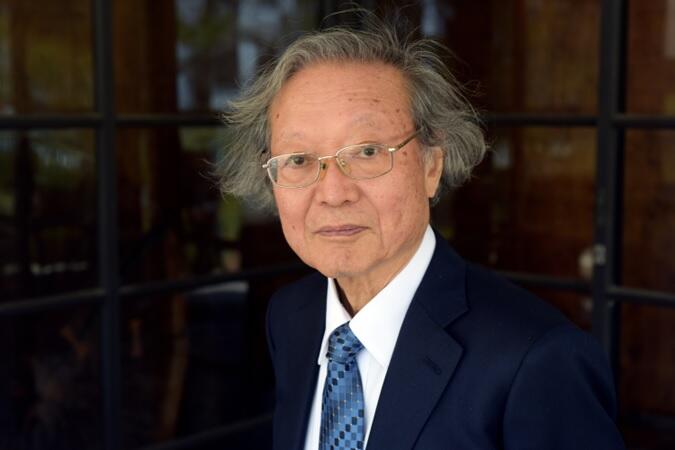The Norwegian Academy of Science and Letters has announced that the Abel Prize, often called the Nobel Prize of mathematics, will be awarded to Program-Specific Professor Masaki Kashiwara of the Research Institute for Mathematical Sciences at Kyoto University. He is the first Japanese recipient of this award. The prize recognizes his significant contributions to algebraic analysis and representation theory, particularly the construction of D-module theory and the creation of crystal base theory. The award ceremony will be held on May 20 at the University of Oslo's Aula (Auditorium), where the King of Norway will present the prize.

Photo provided by Peter Badge/Typos1/The Abel Prize
The Abel Prize was established by the Norwegian government in 2002 to commemorate the 200th anniversary of the birth of Niels Henrik Abel. The prize is awarded to mathematicians who have achieved outstanding results and, unlike the Fields Medal, has no age restriction. The prize money is 7.5 million Norwegian kroner (approximately 100 million yen).
Kashiwara's achievements span multiple fields, including microlocal analysis, partial differential equation theory, representation theory, combinatorics, homological algebra, symplectic geometry, and integrable systems. In his 1970 master's thesis, Kashiwara initiated and developed the theory of analytic D-modules. In particular, he introduced the concept of characteristic variety, significantly extending existence theorems for linear partial differential equations. Furthermore, together with Dr. Takahiro Kawai, he established the microlocal analysis of D-modules. This is a theory that decomposes, analyzes, and classifies D-modules in various directions, essentially solving classical problems such as the solvability of linear partial differential equations and the regularity of solutions.
Around 1980, Kashiwara solved the Riemann-Hilbert conjecture. When considering linear differential equations on curves, a topological "twist" called monodromy occurs in the solution space. Whether all "twists" could be realized as monodromies of differential equations was Hilbert's 21st problem proposed in the early 20th century. Kashiwara formulated and proved this problem in its most general form. Specifically, he established that regular holonomic D-modules and perverse sheaves, which are generalizations of linear differential equations and topological twists respectively, are categorically isomorphic. This theorem, called the "Riemann-Hilbert correspondence," serves as a bridge between the different mathematical worlds of analysis and topology, and is one of the deepest and most important theorems in modern mathematics.
The Riemann-Hilbert correspondence is also extremely important from the perspective of application. In fact, Kashiwara, together with Dr. Jean-Luc Brylinski, used the Riemann-Hilbert correspondence to solve a conjecture in representation theory called the Kazhdan-Lusztig conjecture. The key was translating representation theory problems into topological problems via D-modules. Since the resolution of the conjecture, D-modules have become useful tools not only in linear partial differential equation theory but also in representation theory and are now one of the important fundamental concepts in modern mathematics.
Later, in the 1980s, together with Dr. Pierre Schapira, Kashiwara developed the ideas of microlocal analysis in the theory of sheaves more generally than D-modules. This theory has also had a major influence on the recent development of symplectic geometry. Additionally, he introduced the concept of crystal bases in relation to quantum groups in 1990. This serves as a bridge between representation theory and combinatorics, forming the foundation for fruitful research by many researchers.
In recent years, Kashiwara, along with many collaborators, has continued to achieve outstanding results while introducing new ideas in research such as extending the Riemann-Hilbert correspondence to cases with irregular singularities and categorifying representation theory.
Dreams and hope for young generations
Minister of State for Science and Technology Policy, Minoru Kiuchi: "Dr. Kashiwara being awarded this prize is truly wonderful, and I would like to express my heartfelt congratulations. Mathematics and mathematical sciences are the foundation and basis of all science and technology and are extremely important fields. They are also essential in the development of important technologies such as AI and quantum technology, over which the world is competing for supremacy. This award not only gives dreams and hope to young people who will lead the next generation but also serves as encouragement for many researchers who are currently working hard in the field. As a government, we will continue to work to ensure that excellent research results continue to emerge through the development of outstanding researchers, improvement of research environments, and promotion of basic research."
Impact across research fields
Minister of Education, Culture, Sports, Science and Technology Toshiko Abe commented, "I understand that this award highly values Dr. Kashiwara's outstanding achievements in various fields including algebraic analysis and representation theory and recognizes that he has widely contributed to the development of modern mathematics and his influence has extended across research fields such as physics. The day before yesterday, I issued a ministerial statement, and yesterday, I expressed my congratulations to Dr. Kashiwara by telephone. He shared that what is important in academic research is to create something new, along with encouragement for young people who will lead the next generation to devote themselves to this. He and also expressed his awareness of issues related to opportunities for Japan's excellent young researchers. The Ministry of Education, Culture, Sports, Science and Technology will further promote the creation of environments where researchers can concentrate on original research."
This article has been translated by JST with permission from The Science News Ltd. (https://sci-news.co.jp/). Unauthorized reproduction of the article and photographs is prohibited.




